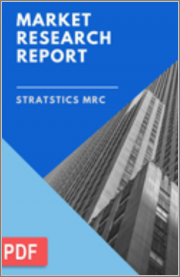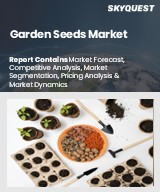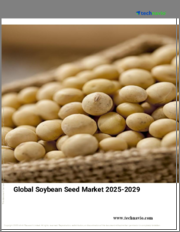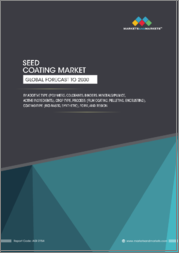
|
시장보고서
상품코드
1324206
세계의 종자 시장 예측(-2030년) : 유형별, 육종 기술별, 재배 메커니즘별, 작물 유형별, 종자 처리별, 가용성별, 지역별 분석Seeds Market Forecasts to 2030 - Global Analysis By Type, Breeding Technology, Cultivation Mechanism, Crop Type, Seed Treatment, Availability and By Geography |
||||||
Stratistics MRC에 따르면 세계 종자 시장은 2023년 668억 5,000만 달러로 예측 기간 동안 CAGR 8.6%로 성장해 2030년 1,190억 9,000만 달러에 달할 것으로 예상됩니다.
부모 식물의 생식 단위는 종자이며, 보호막으로 덮인 묘목 식물입니다. 종자는 농업에서 중요한 역할을 하며 다양한 동물 종의 먹이를 제공합니다. 농업에서 종자의 역할은 지난 수십 년 동안 기술 발전과 그에 따른 개량 종자의 도입으로 인해 크게 증가했습니다.
인도종자산업연맹 사무국장에 따르면, 현장 직원 감축, 다중 교대제 실시, 사회적 거리두기, 잦은 공장 소독, 직원들의 정기적인 건강 모니터링 등이 인도 종자 가공 공장의 생산성을 떨어뜨렸다고 합니다.
시장 역학:
하이브리드 채소 종자 사용 증가
농민과 소비자의 요구를 충족시키기 위해 하이브리드 종자가 만들어집니다. 적응성, 영양, 맛, 수확량, 색상, 모양, 크기, 요리 품질, 풍미, 저장 기간 등은 하이브리드 채소가 가진 특성 중 일부에 불과합니다. 하이브리드 종자는 비하이브리드 종자보다 우수하기 때문에 하이브리드 종자의 인기가 점점 더 높아지고 있습니다. 하이브리드 종자를 활용하면 농부들은 해충과 식물병해충을 포함한 다양한 환경적 스트레스로부터 작물을 보호할 수 있습니다. 또한, 이러한 종자는 일년 내내 높은 수확량과 신뢰할 수 있는 성능을 발휘할 수 있는 잠재력을 가지고 있습니다. 지난 30년간 농부들이 하이브리드 종자를 받아들이면서 여러 종자 회사들이 확장하고 있으며, 사업자들은 고품질 종자를 제공해야 할 필요성이 대두되고 있습니다.
기후변화
세계 농업 생산에 있어 중요한 문제는 기후 변화입니다. 농작물 생산량은 기후변화의 영향을 많이 받고, 농작물은 병충해에 취약합니다. 이는 작물의 건강에 영향을 미치고 농업 방식을 변화시킵니다. 수십 년간의 연구를 통해 기온, 강수량, 습도가 계절에 따라 병해충과 그 발생, 종자 재료의 증식에 영향을 미쳐 작물에 큰 손실을 가져온다는 것이 입증되었습니다. 그 결과, 채소 생산은 기온의 변화와 공기 중의 수분 함량 증가에 영향을 받습니다.
채소 섭취의 장점에 대한 지식의 확대
세계보건기구(WHO)의 추산에 따르면, 전 세계적으로 170만 명이 과일과 채소를 제대로 섭취하지 않거나 섭취하지 않아 사망하고 있습니다. 또한 세계 10대 사망 위험 요인 중 하나도 과일과 채소 섭취 부족입니다. 따라서 과일과 채소를 자주 먹는 것은 부유한 경제권에서든 신흥 경제권에서든 채소 이외의 심각한 문제를 피하는 데 도움이 될 수 있습니다. 채소 생산량을 늘리기 위해 전 세계 생산자들은 고품질 채소 재배용 종자를 포함한 다양한 농업 투입물을 활용하고 있습니다.
관개시설이 부족한 곳에서의 낮은 수확량
쌀, 옥수수, 밀, 땅콩, 유채, 겨자, 콩, 해바라기, 홍화 등은 신흥국에서 재배되는 주요 작물입니다. 이들 작물은 식품, 사료, 화학 분야에 활용되기 때문에 전 세계 종자 산업의 상당 부분을 차지합니다. 이들 작물의 종자 수요가 증가함에 따라 생산량이 많고, 가뭄에 강하며, 내충성이 개선된 작물에 대한 요구가 증가하고 있습니다. 그러나 인도, 남아프리카, 터키와 같은 신흥국에서는 농작물 생산이 강우량에 크게 좌우되어 생산성이 떨어지고 있습니다. 따라서 관개 시스템이 없는 농장은 관개 시스템이 있는 농장보다 생산성이 낮은 것이 분명합니다.
COVID-19의 영향
2020년 1분기, COVID-19의 유행은 종자 인증, 생산, 유통 및 가격에 큰 영향을 미쳤습니다. 또한 경제적으로 개발도상국의 농업과 회복력 있는 식량 시스템은 이 전염병으로 인해 큰 영향을 받았습니다. 운송, 생산 및 문서화 절차를 위한 노동력 부족은 시장에서 종자 및 식물의 가용성 감소와 함께 국제 상업용 종자 생산에 어려움을 겪었습니다.
예측 기간 동안 하이브리드 부문이 가장 큰 비중을 차지할 것으로 예상
하이브리드 분야는 유기농, 동물 사료, 식품 및 바이오 연료 산업에서 하이브리드 종자 및 개방형 수분 종자에 대한 수요가 증가함에 따라 성장세를 보일 것으로 예상됩니다. 하이브리드 종자는 생산량 증가, 유연성 향상, 생물학적 및 생물학적 문제에 대한 높은 내성 등 여러 가지 장점으로 인해 주요 농업 생산국을 중심으로 빠르게 성장하고 있습니다. 환경 변화를 흡수하는 뛰어난 능력은 유연성에 큰 영향을 미칩니다. 새로운 식물 육종 기술은 종자나 식물 세포의 DNA를 변화시킴으로써 원하는 특성을 가진 새로운 종류의 식물을 생산할 수 있게 해줍니다. 식물 육종의 발전은 농부들이 매일 농장에서 겪는 어려움을 극복하는 데 도움이 되고 있습니다.
보호 재배 분야는 예측 기간 동안 가장 높은 CAGR을 보일 것으로 예상
온실 및 기타 온도 조절이 가능한 공간에서 채소를 재배하는 보호 재배 분야는 예측 기간 동안 가장 높은 CAGR을 기록할 것으로 예상됩니다. 보호 재배는 높은 작물 효율성, 기후 제어, 농업에 필요한 적은 투입물 등 많은 이점을 제공하기 때문에 보호된 환경에서 종자 재배에 대한 수요가 증가하고 있습니다.
가장 큰 점유율을 차지하는 지역
아시아태평양은 농업 부문의 확대, 채소의 건강상의 이점에 대한 인식 증가, 원예 작물 재배 면적 확대 등이 주요 시장 촉진요인으로 작용하여 예측 기간 동안 가장 큰 시장 점유율을 차지할 것으로 예상됩니다. 이 지역의 주요 채소 생산 및 소비 국가는 중국과 인도입니다. 이 지역 세계 시장에서의 우위는 중국이 세계 주요 시장이라는 사실에 의해 뒷받침됩니다.
CAGR이 가장 높은 지역:
유럽은 고품질 채소 재배 종자 생산으로 이어지는 육종 방법의 급속한 발전으로 인해 예측 기간 동안 가장 높은 CAGR을 보일 것으로 예상되며, 큰 수요가 있을 것으로 예상됩니다. 또한, 이 지역은 과일과 채소의 주요 생산지이며, 전 세계 채소 상업의 증가로 인해 확대되고 있습니다. 하이브리드 토마토, 양상추, 고추 종자에 대한 수요 증가가 이 산업을 견인하고 있습니다.
무료 맞춤형 서비스:
이 보고서를 구독하는 고객에게는 다음 중 하나의 무료 맞춤화 옵션을 제공합니다:
- 기업 프로필
- 추가 시장 기업의 종합적인 프로파일링(최대 3개사까지)
- 주요 기업 SWOT 분석(3개사까지)
- 지역 세분화
- 고객의 관심에 따른 주요 국가별 시장 추정 및 예측, CAGR(참고: 타당성 검토에 따른)
- 경쟁사 벤치마킹
- 제품 포트폴리오, 지리적 입지, 전략적 제휴를 기반으로 한 주요 기업 벤치마킹
목차
제1장 주요 요약
제2장 서문
- 주요 요약
- 이해관계자
- 조사 범위
- 조사 방법
- 데이터 마이닝
- 데이터 분석
- 데이터 검증
- 조사 접근법
- 조사 소스
- 1차 조사 정보 출처
- 2차 조사 정보 출처
- 가정
제3장 시장 동향 분석
- 성장 촉진요인
- 성장 억제요인
- 기회
- 위협
- 신흥 시장
- COVID-19의 영향
제4장 Porter's Five Forces 분석
- 공급 기업의 교섭력
- 구매자의 교섭력
- 대체품의 위협
- 신규 참여업체의 위협
- 경쟁 기업 간의 경쟁 관계
제5장 세계의 종자 시장 : 유형별
- 유전자 재조합
- 기존
제6장 세계의 종자 시장 : 육종 기술별
- 잡종
- 유전자 재조합 잡종
- 해충 저항성
- 제초제 내성
- 기타 유전자 재조합 잡종
- 비트랜스제닉 잡종
- 유전자 재조합 잡종
- 개방 수분 품종과 하이브리드 파생 품종
- 기타 육종 기술
제7장 세계의 종자 시장 : 재배 메커니즘별
- 보호 재배
- 노지 재배
- 기타 재배 메커니즘
제8장 세계의 종자 시장 : 작물 유형별
- 곡물
- 옥수수
- 쌀
- 밀
- 수수
- 기타 곡물
- 과일·야채
- 박과
- 호박
- 오이·가킨
- 기타 박과
- 가지과
- 나스
- 고추
- 토마토
- 기타 가지과
- 유채과
- 양배추
- 당근
- 콜리플라워&브로콜리
- 기타 유채
- 근채·구근
- 양파
- 마늘
- 감자
- 기타 근채류
- 미분류 야채
- 아스파라거스
- 오크라
- 완두콩
- 양상추
- 시금치
- 기타 분류 되어 있지 않은 야채
- 기타 과일·야채
- 박과
- 지방종자·두류
- 면화
- 대두
- 유채 및 머스터드
- 해바라기
- 카놀라
- 기타 지방종자 및 두류
- 기타 작물
제9장 세계의 종자 시장 : 종자 처리별
- 처리필 봐
- 미처리
제10장 세계의 종자 시장 : 입수 가능성별
- 상업 종자
- 보존 종자
제11장 세계의 종자 시장 : 지역별
- 북미
- 미국
- 캐나다
- 멕시코
- 유럽
- 독일
- 영국
- 이탈리아
- 프랑스
- 스페인
- 기타 유럽
- 아시아태평양
- 일본
- 중국
- 인도
- 호주
- 뉴질랜드
- 한국
- 기타 아시아태평양
- 남미
- 아르헨티나
- 브라질
- 칠레
- 기타 남미
- 중동 및 아프리카
- 사우디아라비아
- 아랍에미리트
- 카타르
- 남아프리카공화국
- 기타 중동 및 아프리카
제12장 주요 발전
- 계약, 파트너십, 제휴, 합작투자
- 인수와 합병
- 신제품 출시
- 사업 확대
- 기타 주요 전략
제13장 기업 개요
- Bayer AG
- BASF SE
- Syngenta Crop Protection AG
- Advanta Seeds
- FMC Corporation
- Royal Barenbrug Group
- KWS SAAT SE & Co. KGaA
- Limagrain
- Corteva
- Sakata Seed Corporation
- Rallis India Limited
- Enza Zaden Beheer B.V.
- Longping High-Tech
- Gansu Dunhuang Seed Co., Ltd
- Kaveri Seed Company
- Henan Goldoctor Seeds Co., Ltd
- Nunhems Seeds Private Ltd.
- China National Seed Group Corp.
- Emerald Seed, Inc.
According to Stratistics MRC, the Global Seeds Market is accounted for $66.85 billion in 2023 and is expected to reach $119.09 billion by 2030 growing at a CAGR of 8.6% during the forecast period. The reproductive unit of the parent plant is the seed, which is a seedling plant covered in a protective covering. They play a significant role in agriculture and provide food for many different animal species. The role of seed in the agriculture industry has increased significantly over the past several decades as a consequence of technical developments and the subsequent introduction of enhanced seed varieties.
According to the Executive Director of the Federation of Seed Industry in India, the reduction in onsite staff, implementation of multiple shifts, social distancing, frequent sanitization of plants, and regular health monitoring of staff led to reduced productivity at Indian seed processing plants.
Market Dynamics:
Driver:
An increase in the use of hybrid vegetable seeds
To meet the needs of farmers and consumers, hybrid seeds are created. Adaptability, nutrition, taste, yield, colour, form, size, cooking quality, flavour, and shelf life are just a few of the traits that hybrid vegetables possess. Due to their advantages over non-hybrid seeds, hybrid seeds are becoming more and more popular. Utilising hybrid vegetable planting seeds enables farmers to protect their crops from a variety of environmental stresses, including pests and plant diseases. These seeds also have the potential for large yields and reliable performance all year long. In the last three decades, farmers' acceptance of hybrid seeds has also fuelled the expansion of several seed firms, which also forces the businesses to provide high-quality seeds.
Restraint:
Climate changes
A key problem for agricultural output worldwide is climate change. Crop output is strongly impacted by climate changes, and crops are vulnerable to pests and diseases. This has an impact on crop health and changes how farming is done. The seasonal effects of temperature, precipitation, and humidity on disease and its formation and propagation on seed material, which causes significant crop loss, have also been demonstrated by decades of research. Consequently, the production of vegetables is impacted by a change in temperature and an increase in air moisture content.
Opportunity:
Growing knowledge on the advantages of eating vegetables
The World Health Organisation (WHO) estimates that 1.7 million deaths worldwide are related to inadequate or nonexistent fruit and vegetable intake. One of the top 10 risk factors for death worldwide is also the inadequate diet of fruits and vegetables. Therefore, eating fruits and vegetables in a regular diet may assist both rich and emerging economies avoid serious non-vegetable problems. In order to increase vegetable output, producers all over the world are utilising a variety of agricultural inputs, including high-quality vegetable planting seeds.
Threat:
Low crop yield in places with inadequate irrigation
Rice, corn, wheat, groundnuts, rapeseed, mustard, soybean, sunflower, and safflower are the main crops grown in emerging nations. As a result of their application in the food, feed, and chemical sectors, these goods account for a sizeable portion of the worldwide seeds industry. These crops' seeds are in more demand, which drives up the need for crops with higher production, greater resilience to drought, and improved insect resistance. However, the production of crops is largely dependent on the rainfall in emerging nations like India, South Africa, and Turkey, which lowers productivity. Thus, it is evident that farms without irrigation systems are less productive than fields with irrigation systems.
COVID-19 Impact:
During the first quarter of 2020, the COVID-19 epidemic had a significant impact on the certification, manufacturing, distribution, and price of seeds. Additionally, the agricultural and resilient food systems in the economically underdeveloped nations were greatly impacted by this epidemic. Lack of labourers for the transportation, production, and documentation procedures, together with a decline in the availability of seeds and plants on the market, made it difficult to produce seeds for international commerce.
The hybrids segment is expected to be the largest during the forecast period
The hybrids segment is estimated to have a lucrative growth, due to the rising demand for hybrid and open-pollinated seeds from organic farmers, the animal feed, food, and biofuel industries. Due to its numerous advantages, such as increased production, greater flexibility, and a high level of tolerance to biotic and abiotic challenges, hybrid seeds have seen rapid expansion, mostly from the major agriculture-producing countries. Their superior ability to absorb environmental changes is largely responsible for their greater flexibility. By altering the DNA of the seeds and plant cells, new plant breeding techniques are enabling the creation of new plant kinds with desired features. Plant breeding advancements are assisting in overcoming the difficulties farmers have on the farm every day.
The protected cultivation segment is expected to have the highest CAGR during the forecast period
The protected cultivation segment is anticipated to witness the highest CAGR growth during the forecast period, due to growing vegetables in greenhouses and other temperature controlled spaces. Due to the many advantages that protected farming provides, including higher crop efficiency, climatic control, and less input needs for agriculture, there is an increasing demand for seed cultivation in protected environments.
Region with largest share:
Asia Pacific is projected to hold the largest market share during the forecast period owing to the main drivers of the market in this region are the expanding agricultural sector, growing public awareness of the health advantages of vegetables, and expanding horticulture crop land. The main nations in the region with high vegetable production and consumption are China and India. The dominance of the area in the global market would also be supported by the fact that China is a major worldwide market.
Region with highest CAGR:
Europe is projected to have the highest CAGR over the forecast period, owing to due to the quick development of breeding methods that result in the creation of high-quality vegetable planting seeds; the European market will see significant demand. Additionally, the area is a major producer of fruits and vegetables, and the expansion is due to an increase in global vegetable commerce. The country's expanding demand for hybrid tomato, lettuce, and sweet pepper seeds is boosting the industry.
Key players in the market:
Some of the key players profiled in the Seeds Market include: Bayer AG, BASF SE, Syngenta Crop Protection AG, Advanta Seeds, FMC Corporation, Royal Barenbrug Group, KWS SAAT SE & Co. KGaA, Limagrain, Corteva, Sakata Seed Corporation, Rallis India Limited, Enza Zaden Beheer B.V., Longping High-Tech, Gansu Dunhuang Seed Co., Ltd, Kaveri Seed Company, Henan Goldoctor Seeds Co., Ltd, Nunhems Seeds Private Ltd., China National Seed Group Corp. and Emerald Seed, Inc.
Key Developments:
In April 2023, Bayer revealed an investment of overall 60 million euros from 2023 onwards in its corn seed production facility in Pochuiky, Ukraine. With this, the life sciences company emphasizes its commitment to Ukraine and strengthens its Crop Science.
In August 2022, Bayer AG, Bunge, and Chevron U.S.A. Inc. (Chevron), a subsidiary of Chevron Corporation, signed a shareholders' agreement in connection with Bayer's acquisition of a 65 percent majority ownership of the winter oilseed producer CoverCress, Inc. (CCI).
In February 2022, BASF's vegetable seeds business developed a tearless onion variety which was launched at supermarkets in France, Germany, Italy, and the United Kingdom.
Types Covered:
- Genetically Modified
- Conventional
Breeding Technologies Covered:
- Hybrids
- Open Pollinated Varieties & Hybrid Derivatives
- Other Breeding Technologies
Cultivation Mechanisms Covered:
- Protected Cultivation
- Open Field
- Other Cultivation Mechanisms
Crop Types Covered:
- Cereals & Grains
- Fruits & Vegetables
- Oilseeds & Pulses
- Other Crop Types
Seed Treatments Covered:
- Treated
- Untreated
Availabilities Covered:
- Commercial Seeds
- Saved Seeds
Regions Covered:
- North America
- US
- Canada
- Mexico
- Europe
- Germany
- UK
- Italy
- France
- Spain
- Rest of Europe
- Asia Pacific
- Japan
- China
- India
- Australia
- New Zealand
- South Korea
- Rest of Asia Pacific
- South America
- Argentina
- Brazil
- Chile
- Rest of South America
- Middle East & Africa
- Saudi Arabia
- UAE
- Qatar
- South Africa
- Rest of Middle East & Africa
What our report offers:
- Market share assessments for the regional and country-level segments
- Strategic recommendations for the new entrants
- Covers Market data for the years 2021, 2022, 2023, 2026, and 2030
- Market Trends (Drivers, Constraints, Opportunities, Threats, Challenges, Investment Opportunities, and recommendations)
- Strategic recommendations in key business segments based on the market estimations
- Competitive landscaping mapping the key common trends
- Company profiling with detailed strategies, financials, and recent developments
- Supply chain trends mapping the latest technological advancements
Free Customization Offerings:
All the customers of this report will be entitled to receive one of the following free customization options:
- Company Profiling
- Comprehensive profiling of additional market players (up to 3)
- SWOT Analysis of key players (up to 3)
- Regional Segmentation
- Market estimations, Forecasts and CAGR of any prominent country as per the client's interest (Note: Depends on feasibility check)
- Competitive Benchmarking
- Benchmarking of key players based on product portfolio, geographical presence, and strategic alliances
Table of Contents
1 Executive Summary
2 Preface
- 2.1 Abstract
- 2.2 Stake Holders
- 2.3 Research Scope
- 2.4 Research Methodology
- 2.4.1 Data Mining
- 2.4.2 Data Analysis
- 2.4.3 Data Validation
- 2.4.4 Research Approach
- 2.5 Research Sources
- 2.5.1 Primary Research Sources
- 2.5.2 Secondary Research Sources
- 2.5.3 Assumptions
3 Market Trend Analysis
- 3.1 Introduction
- 3.2 Drivers
- 3.3 Restraints
- 3.4 Opportunities
- 3.5 Threats
- 3.6 Emerging Markets
- 3.7 Impact of Covid-19
4 Porters Five Force Analysis
- 4.1 Bargaining power of suppliers
- 4.2 Bargaining power of buyers
- 4.3 Threat of substitutes
- 4.4 Threat of new entrants
- 4.5 Competitive rivalry
5 Global Seeds Market, By Type
- 5.1 Introduction
- 5.2 Genetically Modified
- 5.3 Conventional
6 Global Seeds Market, By Breeding Technology
- 6.1 Introduction
- 6.2 Hybrids
- 6.2.1 Transgenic Hybrids
- 6.2.1.1 Insect Resistant
- 6.2.1.2 Herbicide Tolerant
- 6.2.1.3 Other Transgenic Hybrids
- 6.2.2 Non-Transgenic Hybrids
- 6.2.1 Transgenic Hybrids
- 6.3 Open Pollinated Varieties & Hybrid Derivatives
- 6.4 Other Breeding Technologies
7 Global Seeds Market, By Cultivation Mechanism
- 7.1 Introduction
- 7.2 Protected Cultivation
- 7.3 Open Field
- 7.4 Other Cultivation Mechanisms
8 Global Seeds Market, By Crop Type
- 8.1 Introduction
- 8.2 Cereals & Grains
- 8.2.1 Corn
- 8.2.2 Rice
- 8.2.3 Wheat
- 8.2.4 Sorghum
- 8.2.5 Other Cereals & Grains
- 8.3 Fruits & Vegetables
- 8.3.1 Cucurbits
- 8.3.1.1 Pumpkin & Squash
- 8.3.1.2 Cucumber & Gherkin
- 8.3.1.3 Other Cucurbits
- 8.3.2 Solanaceae
- 8.3.1.1 Eggplant
- 8.3.1.2 Chilli
- 8.3.1.3 Tomato
- 8.3.1.4 Other Solanaceaes
- 8.3.3 Brassicas
- 8.3.3.1 Cabbage
- 8.3.3.2 Carrot
- 8.3.3.3 Cauliflower & Broccoli
- 8.3.3.4 Other Brassicas
- 8.3.4 Roots & Bulbs
- 8.3.4.1 Onion
- 8.3.4.2 Garlic
- 8.3.4.3 Potato
- 8.3.4.4 Other Roots & Bulbs
- 8.3.5 Unclassified Vegetables
- 8.3.5.1 Asparagus
- 8.3.5.2 Okra
- 8.3.5.3 Peas
- 8.3.5.4 Lettuce
- 8.3.5.5 Spinach
- 8.3.5.6 Other Unclassified Vegetables
- 8.3.6 Other Fruits & Vegetables
- 8.3.1 Cucurbits
- 8.4 Oilseeds & Pulses
- 8.4.1 Cotton
- 8.4.2 Soybean
- 8.4.3 Rapeseed & Mustard
- 8.4.4 Sunflower
- 8.4.5 Canola
- 8.4.6 Other oilseeds & Pulses
- 8.5 Other Crop Types
9 Global Seeds Market, By Seed Treatment
- 9.1 Introduction
- 9.2 Treated
- 9.3 Untreated
10 Global Seeds Market, By Availability
- 10.1 Introduction
- 10.2 Commercial Seeds
- 10.3 Saved Seeds
11 Global Seeds Market, By Geography
- 11.1 Introduction
- 11.2 North America
- 11.2.1 US
- 11.2.2 Canada
- 11.2.3 Mexico
- 11.3 Europe
- 11.3.1 Germany
- 11.3.2 UK
- 11.3.3 Italy
- 11.3.4 France
- 11.3.5 Spain
- 11.3.6 Rest of Europe
- 11.4 Asia Pacific
- 11.4.1 Japan
- 11.4.2 China
- 11.4.3 India
- 11.4.4 Australia
- 11.4.5 New Zealand
- 11.4.6 South Korea
- 11.4.7 Rest of Asia Pacific
- 11.5 South America
- 11.5.1 Argentina
- 11.5.2 Brazil
- 11.5.3 Chile
- 11.5.4 Rest of South America
- 11.6 Middle East & Africa
- 11.6.1 Saudi Arabia
- 11.6.2 UAE
- 11.6.3 Qatar
- 11.6.4 South Africa
- 11.6.5 Rest of Middle East & Africa
12 Key Developments
- 12.1 Agreements, Partnerships, Collaborations and Joint Ventures
- 12.2 Acquisitions & Mergers
- 12.3 New Product Launch
- 12.4 Expansions
- 12.5 Other Key Strategies
13 Company Profiling
- 13.1 Bayer AG
- 13.2 BASF SE
- 13.3 Syngenta Crop Protection AG
- 13.4 Advanta Seeds
- 13.5 FMC Corporation
- 13.6 Royal Barenbrug Group
- 13.7 KWS SAAT SE & Co. KGaA
- 13.8 Limagrain
- 13.9 Corteva
- 13.10 Sakata Seed Corporation
- 13.11 Rallis India Limited
- 13.12 Enza Zaden Beheer B.V.
- 13.13 Longping High-Tech
- 13.14 Gansu Dunhuang Seed Co., Ltd
- 13.15 Kaveri Seed Company
- 13.16 Henan Goldoctor Seeds Co., Ltd
- 13.17 Nunhems Seeds Private Ltd.
- 13.18 China National Seed Group Corp.
- 13.19 Emerald Seed, Inc.



















